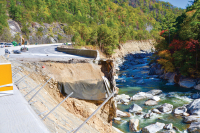No compromise
When I was a full-time staff writer at the Smoky Mountain News, I spent a lot of time covering the North Shore Road controversy.
I interviewed and talked with proponents of the road, opponents of the road, local politicians and Park Service officials. I went to public meetings, and I went on hikes to Proctor and other areas along the North Shore of Fontana. I think it was on these hikes that I realized that for many the Road to Nowhere was actually the road back home. Many of the most ardent road supporters could have hardly cared less about getting from the end of the tunnel to Deal’s Gap or Fontana Dam. They wanted to get back to Proctor, Bushnell, Hazel Creek, Forney Creek – they wanted to get back home. They wanted to walk back up to the stoops and old chimneys that now sit forlornly surrounded by the jonquils and apple trees that used to be the yards they played in as children.
Those yards were taken because Tennessee Valley Authority wanted to build a dam at Fontana. According to TVA’s own Web site (www.tva.gov/heritage/ fontana/index.htm), “TVA had wanted to build a hydroelectric dam at Fontana since the early days, but an agreement with the Aluminum Company of America (Alcoa), which controlled the land, was elusive.” The war changed that as the government put Alcoa in the military business. TVA got its wish and Fontana Dam came online in 1945 with only six months left in the war.
I was encouraged when I heard members of the Citizens for the Economic Future of Swain County (the Swain County group pushing for a cash settlement) talking to Swain commissioners about a museum honoring those displaced from the North Shore and setting up better cemetery access, but compromise wasn’t in the cards.
I think many in the North Shore Road Association were still smarting from contentious battles with environmentalists in the ‘60s and ‘70s when there was a movement to try to have the North Shore designated as a Wilderness Area.
Related Items
While I am no advocate of building a road it looks like road proponents have backed themselves into a corner and this saddens me. I know sentiments like that will never get me an official Earth Firstier card, and I may not be invited to any Wildlands Project meetings, but I feel that some kind of North Shore recognition of the human sacrifice involved would be appropriate.
However, when I talked with National Park Service personnel about the impending preferred alternative — which has been delayed due to the appointment of a new Secretary of the Interior and a new National Park Service director — I was told that compromises like the Laurel Branch Picnic Area received little play during the public comment period of the Draft Environmental Impact Statement. The overwhelming majority of comments centered on either building the road or accepting a cash settlement.
A hundred years from now the North Shore may be a wilderness. But sojourners to this wilderness will still find the rusted skeletons of automobiles, bottles and shards of glass as well as remnant jonquils, periwinkle, English ivy and mimosa. It would be fitting for the Park Service to tell the story of how this came to be.









